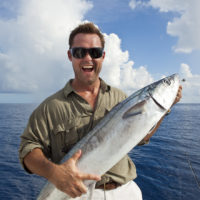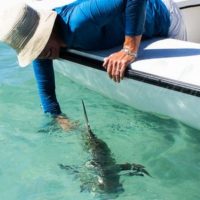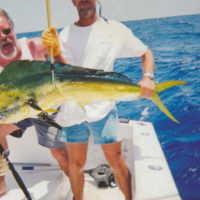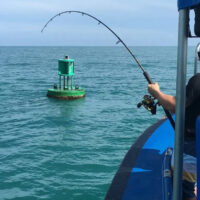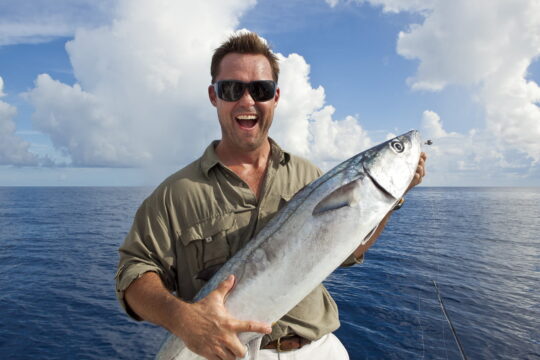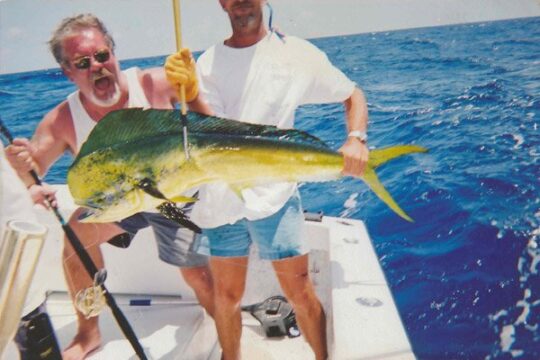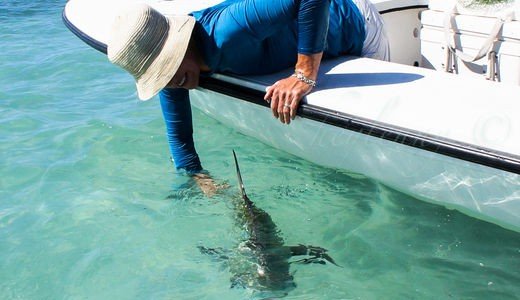Fishing for Bull Shark in Key West
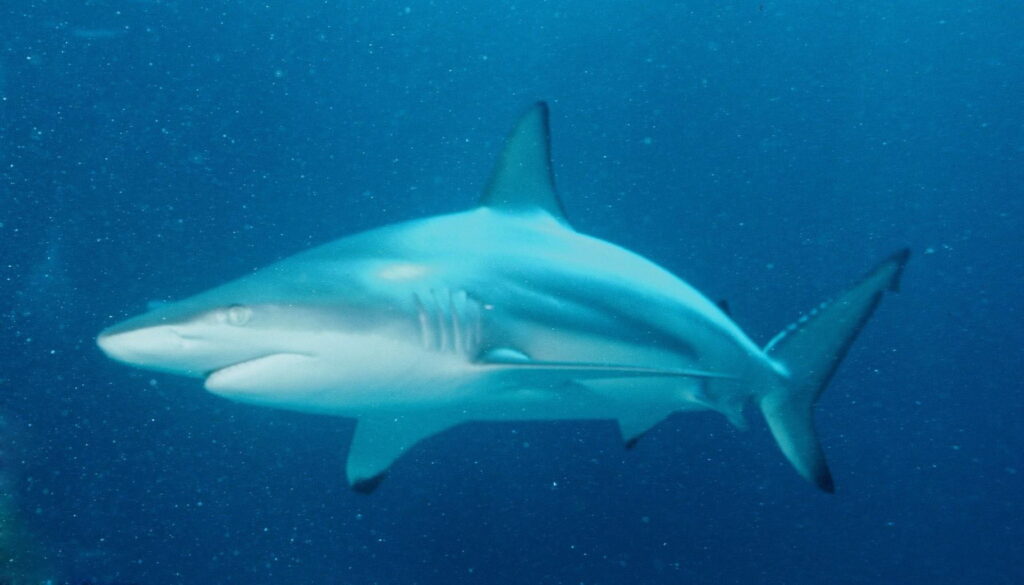
The Bull Shark is a popular game fish in the southeastern US and is often targeted from shore, piers, and bridges. Around Key West, Bull Sharks can be found everywhere, with the deeper Atlantic wrecks and the Gulf wrecks in more than 120 feet of water being especially good for Bull Shark fishing. (Florida Record: 517lbs)
Bull Shark (Carcharhinus leucas)
The Bull Shark gets its name from its heavy, thick body. The body is deep and much stockier than many other Shark species. It also has a broad, flat snout and the unpredictable aggressive behavior of an angry bull. The snout is blunt and round, shorter than the width of the mouth. A Bull Shark’s jaws can deliver a bite force of up to 1,330lbs per foot, weight-for-weight the strongest bite of all cartilaginous fishes that have been measured.
Bull Sharks have grey coloration on their backs and white on their undersides. The dorsal and pectoral fins are large and triangular, and the fins of younger Sharks have black tips, which fade to a dusky color as they grow. Bull Sharks have relatively small eyes compared to other large Sharks of similar species, suggesting that vision is not an important hunting tool in the muddy waters where these Sharks are often found.
Bull Shark females grow larger than males and average nearly 8 feet in length and 285 pounds in weight. This is due to a longer lifespan, as females live about 16 years as compared to 12 years for males. However, it is thought that some individuals may live as long as 30 years. Recently, estimates of the maximum possible weight for these Sharks have been updated as female Bull Sharks in the 8-foot and 700 to 800lb range have been caught off the Florida Keys (694lbs) and in the Arabian Sea off Fujairah, United Arab Emirates (800lb & 767lb).
Bull Shark Habitat and Behavior
Bull Sharks are found in tropical to subtropical waters worldwide, particularly in shallow water along coasts. They are known for inhabiting the brackish, muddy waters of estuaries and coastal rivers. The Bull Shark prefers waters less than 100 feet deep, but can also range from 300-450 feet deep. In the western Atlantic, Bull Sharks migrate north along the coast of the US during summer, moving as far north as Massachusetts, and then returning to tropical climates as far south as southern Brazil when the coastal waters cool.
The Bull Shark is unique because it is the only Shark species that readily enters fresh water, and often seems to prefer brackish or fresh water. Bull Sharks can travel far up inland river systems, and they have been reported as far as 2220 miles up the Amazon River to Iquitos in Peru, and over 700 miles up the Mississippi River to Alton, Illinois. Populations inhabit rivers and canals in Queensland, Australia. Bull Sharks are found in the Ganges and Brahmaputra Rivers of India and Bangladesh. There is also a population in Lake Nicaragua in Central America that permanently inhabits the freshwater lake, moving between the lake and the ocean through rivers and estuaries to breed and feed.
The kidneys, liver, gills, and other organs are adapted to allow the Bull Shark to regulate itself to live in either fresh or salt water, but the Bull Shark is not known to spend its entire life in fresh water. They move into the open sea to breed, then return to bear their young in the brackish water of estuaries. The majority of newborn or very young Bull Sharks are found in the freshwater areas of estuaries, while older Sharks have more tolerance for extremes of high or low salinity.
Bull Sharks in the Gulf of Mexico mate during the summer months, with pups born the following spring from April to June. In the warmest parts of the Bull Shark’s range, mating occurs year-round. From 1 to 13 pups are gestated for 10-11 months, then are born live and ready to swim. The young Bull Sharks commonly use coastal lagoons, river mouths, and other low-salinity estuaries as nursery habitats.
Although Bull Sharks are opportunistic feeders, bony fishes and small sharks make up most of their diet. Bull Sharks of the western Atlantic commonly feed on many types of schooling fish including mullet, tarpon, catfishes, menhaden, gar, snook, jacks, mackerel, and snappers. They also prey on stingrays and juvenile sharks, including the young of their own species in their inshore nursery habitats. Other food items occasionally reported being found in the stomachs of Bull Sharks include sea turtles, dolphins, crabs, shrimp, sea birds, squid, and dogs.
Bull Sharks may appear sluggish with their thick bodies and slow movement along the bottom, but they are actually quite quick and effective at capturing smaller, agile prey. Bull Sharks are considered to be one of the most dangerous species of Shark to humans because they often inhabit shallow waters near heavily-populated estuarine areas. Many Bull Shark attacks are attributed to the Shark’s aggressive nature and habit of hunting in murky, low-visibility water, factors that increase the chances of a person being mistaken for prey.
Fishing for Bull Sharks
With a good charter captain, Bull Shark fishing in Key West is almost guaranteed to be successful. The deep wrecks off the island hold Bull Sharks that run 10-12 feet in length. These big Sharks are followed around by large schools of Cobia looking for the scraps of the Bull Shark’s meals. On the Flats, Bull Sharks can be found around the deeper channels. As with any Shark species, any type of large baitfish works well on Bull Sharks, but oily fish such as big fresh Bonita and Barracuda are the best.
Expect a long, hard fight when you hook a big Bull Shark as these are very strong, heavy Sharks. The International Game Fish Association world record for the largest Bull Shark caught on rod and reel stands at 771 lbs 9 oz, caught near Cairns, Australia. You can easily expect to find Bull Sharks of 200 lbs and more in Key West waters.

